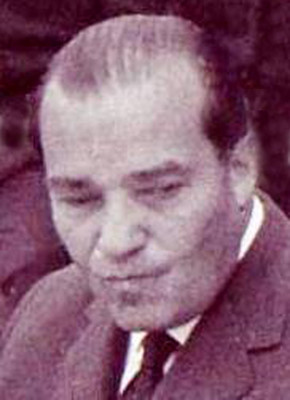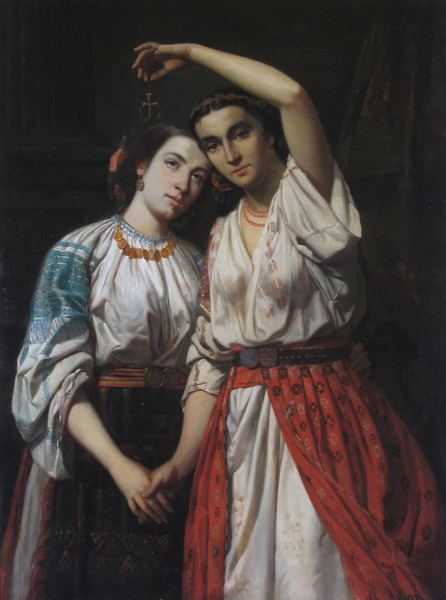|
Maximilian Hacman
Maximilian Hacman ( – October 11, 1961) was an Austro-Hungarian-born Romanian jurist. Biography Early life and Bukovina union role Born in Oprișeni, in Austrian-ruled Bukovina, his uncle was Romanian Orthodox metropolitan Eugenie Hacman, while his father Vasile served as the village priest from 1857 to 1879. After attending primary school in Oprișeni, he went to high school in Czernowitz (''Cernăuți''). He then enrolled in Czernowitz University, studying at the law faculty and becoming a jurist specialized in commercial and trade law. He took his doctorate in 1904 and, esteemed by his professors, was sent to complete his studies at Berlin and Zurich from 1909 to 1910.Bruja, p. 348 Becoming a political activist on behalf of the region's Romanians, he entered Societatea Academică Junimea and served as its president in 1901. After returning home from Berlin, he continued his involvement with Romanian organizations, holding conferences on various topics. The first of th ... [...More Info...] [...Related Items...] OR: [Wikipedia] [Google] [Baidu] |
Austria-Hungary
Austria-Hungary, often referred to as the Austro-Hungarian Empire,, the Dual Monarchy, or Austria, was a constitutional monarchy and great power in Central Europe between 1867 and 1918. It was formed with the Austro-Hungarian Compromise of 1867 in the aftermath of the Austro-Prussian War and was dissolved shortly after its defeat in the First World War. Austria-Hungary was ruled by the House of Habsburg and constituted the last phase in the constitutional evolution of the Habsburg monarchy. It was a multinational state and one of Europe's major powers at the time. Austria-Hungary was geographically the second-largest country in Europe after the Russian Empire, at and the third-most populous (after Russia and the German Empire). The Empire built up the fourth-largest machine building industry in the world, after the United States, Germany and the United Kingdom. Austria-Hungary also became the world's third-largest manufacturer and exporter of electric home appliances, ... [...More Info...] [...Related Items...] OR: [Wikipedia] [Google] [Baidu] |
Democratic Union Party (Bukovina)
The Democratic Union Party ( ro, Partidul Democrat al Unirei or ', PDU) was a political group in Romania, one of the political forces which claimed to represent the ethnic Romanian community of Bukovina province. The PDU was active in the wake of World War I, between 1919 and 1923, having for its leader the historian and nationalist militant Ion Nistor. It was formed by Nistor and other activists who wrote for the regional periodical '' Glasul Bucovinei'', and, as a consequence, the party members were commonly referred to as ''Glasiști'' ("Glas-ists"). The PDU favored a centralist administration, pushed for Romanianization in public life, and was generally hostile to the centrifugal tendencies of other communities, primarily Ukrainians, Germans, Poles and Jews. These together formed a relative majority of Bukovina's population, and Nistor's agenda met with sustained opposition from all sides of the region's political spectrum, although the PDU was successful in rallying to its ca ... [...More Info...] [...Related Items...] OR: [Wikipedia] [Google] [Baidu] |
Traian Brăileanu
Traian Brăileanu or BrăileanAndrei Corbea-Hoișie, "'Wie die Juden Gewalt schreien': Aurel Onciul und die antisemitische Wende in der Bukowiner Öffentlichkeit nach 1907", in ''East Central Europe'', Vol. 39, Issue 1, 2012, p. 22 (September 14, 1882 – October 3, 1947) was an Austro-Hungarian-born Romanian sociologist and politician. A native of the Bukovina region, he attended Czernowitz University, where he studied philosophy and classical languages, subsequently earning a doctorate. Ending up as a translator in Vienna, he fought for Austria during World War I. At the conclusion of hostilities, returned to the renamed Cernăuți, now part of Greater Romania. There, he soon became a professor of sociology, leading a "Cernăuți School" of academics during the interwar period. Meanwhile, he was involved in nationalist politics, supporting Alexandru Averescu, Nicolae Iorga and, ultimately, the extremist Iron Guard, of which he was among the most prominent intellectual backers. ... [...More Info...] [...Related Items...] OR: [Wikipedia] [Google] [Baidu] |
Ministry Of Education And Scientific Research (Romania)
The Ministry of Education ( ro, Ministerul Educației Naționale) is one of the ministries of the Government of Romania. - official site Former names of the Ministry Over the years the Ministry changed its title. Initially it was called ''Ministry of Religion and Public Instruction'' ( ro, Ministerul Religiei și Instrucțiunii Publice), then ''Ministry of Public Instruction'' ( ro, Ministerul Instrucțiunii Publice), then it changed to ''Ministry of Teaching'' ( ro, Ministerul Învǎțǎmântului), ''Ministry of Teaching and Science'' ( ro, Ministerul Învǎțǎmântului și Științei), then changed back to ''Ministry of Teaching'' ( ro, Ministerul Învǎțǎmântului). When became Minister, it introduced the la ...[...More Info...] [...Related Items...] OR: [Wikipedia] [Google] [Baidu] |
Carol II Of Romania
Carol II (4 April 1953) was King of Romania from 8 June 1930 until his forced abdication on 6 September 1940. The eldest son of Ferdinand I, he became crown prince upon the death of his grand-uncle, King Carol I in 1914. He was the first of the Hohenzollern kings of Romania to be born in the country; both of his predecessors had been born in Germany and came to Romania only as adults. As such, he was the first member of the Romanian branch of the Hohenzollerns who spoke Romanian as his first language, and was also the first member of the royal family to be raised in the Orthodox faith. Carol was also a fan of football, being the Romanian Football Federation's president for almost one year from 1924 until 1925. Carol's first controversy was his desertion from the army during World War I, followed by his marriage to Zizi Lambrino, which resulted in two attempts to give up the rights of succession to the royal crown of Romania, refused by King Ferdinand. After the dissolution ... [...More Info...] [...Related Items...] OR: [Wikipedia] [Google] [Baidu] |
National Renaissance Front
The National Renaissance Front ( ro, Frontul Renașterii Naționale, FRN; also translated as ''Front of National Regeneration'', ''Front of National Rebirth'', ''Front of National Resurrection'', or ''Front of National Renaissance'') was a Romanian political party created by King Carol II in 1938 as the single monopoly party of government following his decision to ban all other political parties and suspend the 1923 Constitution, and the passing of the 1938 Constitution of Romania. It was the party of Prime Ministers Armand Călinescu, Gheorghe Argeșanu, Constantin Argetoianu, Gheorghe Tătărescu, and Ion Gigurtu, whose regimes were associated with corporatism and antisemitism. Largely reflecting Carol's own political choices, the FRN was the last of several attempts to counter the popularity of the fascist and antisemitic Iron Guard. In mid-1940, Carol reorganized the FRN into the more radical Party of the Nation ( or , PN), designed as a "totalitarian unity party". The par ... [...More Info...] [...Related Items...] OR: [Wikipedia] [Google] [Baidu] |
Romanian Senate
) is the upper house in the bicameral Parliament of Romania. It has 136 seats (before the 2016 Romanian legislative election the total number of elected representatives was 176), to which members are elected by direct popular vote using party-list proportional representation in 43 electoral districts (the 41 counties, the city of Bucharest plus 1 constituency for the Romanians living abroad), to serve four-year terms. History First Senate (1859–1944) The parliamentary history of Romania is seen as beginning in May 1831 in Wallachia, where a constitution called Regulamentul Organic ("Organic Statute") was promulgated by the Russian Empire and adopted. In January 1832 it came into force in Moldavia also. This laid the foundations for the parliamentary institution in the two Romanian principalities. At the Congress of Paris of 1856, Russia gave up to Moldavia the left bank of the mouth of the Danube, including part of Bessarabia, and also gave up its claim to be the protector of ... [...More Info...] [...Related Items...] OR: [Wikipedia] [Google] [Baidu] |
Focșani
Focșani (; yi, פֿאָקשאַן, Fokshan) is the capital city of Vrancea County in Romania on the banks the river Milcov, in the historical region of Moldavia. It has a population () of 79,315. Geography Focșani lies at the foot of the Curvature Carpathians, at a point of convergence for tectonic geologic faults, which raises the risk of earthquakes in the vicinity. Though Vrancea County is one of the most popular wine-producing regions in Romania, Odobești being just to the northwest, in Romania, Focșani itself is not considered a wine-producing center. The wine sold as ''Weisse von Fokshan'' in Germany and some other European countries is generally a ''Fetească Albă de Odobești'' wine, and practically a second-rated wine which does not comply to the European Union rules of naming the regions of origin of wines. The vicinity is rich in minerals such as iron, copper, coal, and petroleum. The city administers two villages, Mândrești-Moldova and Mândrești-Munteni. ... [...More Info...] [...Related Items...] OR: [Wikipedia] [Google] [Baidu] |
National Archives Of Romania
The National Archives of Romania ( ro, Arhivele Naţionale ale României), until 1996 the State Archives (''Arhivele Statului''), are the national archives of Romania, headquartered in Bucharest. It is subordinate to the Ministry of Internal Affairs. There are 42 regional branches, one in each county of Romania and one in Bucharest (holding documents pertaining specifically to the city). Attributes By law nr. 16/1996 (modified by law nr.138/2013, in order to update the existing law and comply with EU requirements), the Archives establishes norms for archival activity; implements measures from the law on archives; receives documents for the National Archival Deposit of Romania; inventories, selects and preserves the documents it holds; preserves documents on microfilm and other formats; maintains an archival database; edits the quarterly ''Revista Arhivelor'' and other specialty publications; ensures the training of qualified archivists through the Archival Faculty and the Nati ... [...More Info...] [...Related Items...] OR: [Wikipedia] [Google] [Baidu] |



